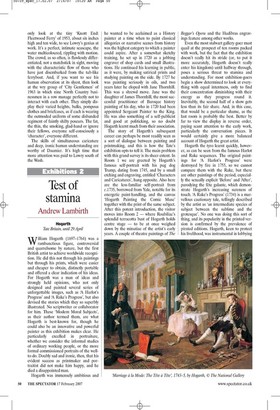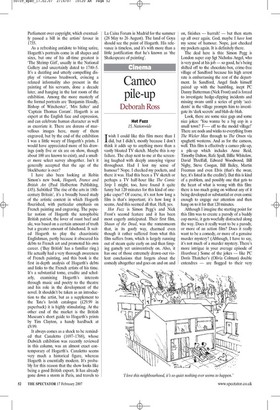Test of stamina
Andrew Lambirth Hogarth Tate Britain, until 29 April William Hogarth (1697-1764) was a rambunctious figure, controversial and quarrelsome by nature, but the first British artist to achieve worldwide recognition. He did this not through his paintings but through his prints, which were easier and cheaper to obtain, distinctly portable and offered a clear indication of his ideas. For Hogarth was a man of ideas and strongly held opinions, who not only designed and painted several series of unforgettable images, such as 'A Harlot's Progress' and 'A Rake's Progress', but also devised the stories which they so superbly illustrated. No scriptwriter or collaborator for him These 'Modern Moral Subjects', as their author termed them, are what Hogarth is best-known for, though he could also be an innovative and powerful painter as this exhibition makes clear. He particularly excelled in portraiture, whether we consider the informal studies of ordinary working people, or the more formal commissioned portraits of the wellto-do. Doubly sad and ironic, then, that his evident success as printmaker and portraitist did not make him happy, and he died a disappointed man.
Hogarth was immensely ambitious and he wanted to be acclaimed as a History painter at a time when to paint classical allegories or narrative scenes from history was the highest category to which a painter could aspire. After a somewhat sketchy training, he set up in 1720 as a jobbing engraver of shop cards and small illustrations. He continued his learning in public, as it were, by making satirical prints and studying painting on the side. By 1727 he was painting seriously in oils, and two years later he eloped with Jane Thornhill. This was a shrewd move. Jane was the daughter of James Thornhill, the most successful practitioner of Baroque history painting of his day, who in 1720 had been appointed Sergeant Painter to the King. He was also something of a self-publicist and good at politicking, so no doubt Hogarth learnt much from their association.
The story of Hogarth's subsequent career can perhaps be most readily seen as a sort of dialogue between painting and printmaking, and this is how the Tate's exhibition opts to tell it. The main problem with this grand survey is its sheer extent. In Room 1 we are greeted by Hogarth's famous self-portrait with his pug dog Trump, dating from 1745, and by a small etching and engraving, entitled 'Characters and Caricatures', hung opposite. Also here are the less-familiar self-portrait from c.1735, borrowed from Yale, notable for its energetic paint-handling, and the canvas `Hogarth Painting the Comic Muse' together with the print of the same subject. After this potent introduction, the visitor moves into Room 2 — where Roubiliac's splendid terracotta bust of Hogarth holds centre stage — to be at once weighed down by the minutiae of the artist's early years. A couple of theatre paintings of The Beggar's Opera and the Hudibras engravings feature among other works.
Even the most stalwart gallery-goer must quail at the prospect of ten rooms packed with work, but the fact that the exhibition doesn't really hit its stride (or, to put it more accurately, Hogarth doesn't really enter his kingdom) until halfway through, poses a serious threat to stamina and understanding. For most exhibition-goers begin a show determined to look at everything with equal intentness, only to find their concentration diminishing with their energy as they progress round it. Inevitably, the second half of a show gets less than its fair share. And, in this case, that would be a particular shame, as the last room is probably the best. Better by far to view the display in reverse order, paying scant attention to the early work, particularly the conversation pieces. It would certainly give a more balanced account of Hogarth the great artist.
Hogarth the tyro learnt quickly, however, as can be seen from the famous Harlot and Rake sequences. The original paintings for 'A Harlot's Progress' were destroyed by fire in 1755, so we cannot compare them with the Rake, but there are other paintings of the period, especially the sexually explicit 'Before' and 'After', parodying the fête galante, which demonstrate Hogarth's increasing sureness of touch. 'A Rake's Progress' (1734) is a marvellous cautionary tale, tellingly described by the artist as 'an intermediate species of subject between the sublime and the grotesque'. No one was doing this sort of thing, and its popularity in the printed version is confirmed by the prevalence of pirated editions. Hogarth, keen to protect his livelihood, was instrumental in lobbying Parliament over copyright, which eventually passed a bill in the artists' favour in 1735.
As a refreshing antidote to biting satire, Hogarth's portraits come in all shapes and sizes, but one of his all-time greatest is 'The Shrimp Girl', usually in the National Gallery and uncertainly dated to 1740-5. It's a dazzling and utterly compelling display of virtuoso brushwork, evincing a relaxed informality also present in the painting of his servants, done a decade later, and hanging in the last room of the exhibition. Among the more masterly of the formal portraits are 'Benjamin Hoadly, Bishop of Winchester', 'Mrs Salter' and 'Captain Thomas Coram'. Hogarth is an expert at the English face and expression, and can celebrate human character as well as excoriate it. There are dozens of marvellous images here, many of them engraved, but by the end of the exhibition I was a little weary of Hogarth's prints. I would have appreciated more of his drawings (only five or six are on show, though about 100 are known to exist), and a smaller more select survey altogether. Isn't it generally accepted that the age of the blockbuster is over?
I have also been looking at Robin Simon's new book, Hogarth, France and British Art (Paul Holberton Publishing, £45). Subtitled 'The rise of the arts in 18thcentury Britain', it's a broadly based study of the artistic context in which Hogarth flourished, with particular emphasis on French painting and engraving. The popular notion of Hogarth the xenophobic British patriot, the lover of roast beef and ale, was based on a certain amount of truth but a greater amount of falsehood. It suited Hogarth to play the chauvinistic Englishman, partly because it obscured his debts to French art and promoted his own career. (Buy British' has a familiar ring.) He actually had a very thorough awareness of French painting, and this book is the first in-depth analysis of Hogarth's debts and links to the French artists of his time. It's a substantial tome, erudite and scholarly, examining Hogarth's interests through music and poetry to the theatre and his role in the development of the novel. It shouldn't be taken as an introduction to the artist, but as a supplement to the Tate's lavish catalogue (£29.99 in paperback) it is highly stimulating. At the other end of the market is the British Museum's short guide to Hogarth's prints by Tim Clayton, a handy hardback at £9.99.
It always comes as a shock to be reminded that Canaletto (1697-1768), whose Dulwich exhibition was recently reviewed in this column, was an almost exact contemporary of Hogarth's. Canaletto seems very much a historical figure, whereas Hogarth is essentially modern. It's probably for this reason that the show looks like being a good British export. It has already gone down a storm in Paris, and travels to La Caixa Forum in Madrid for the summer (28 May to 26 August). The land of Goya should see the point of Hogarth. His relevance is timeless, and it's with more than a little justification that he's known as `the Shakespeare of painting'.


























































 Previous page
Previous page